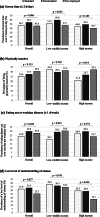Mothers' nonstandard work schedules and adolescent obesity: a population-based cross-sectional study in the Tokyo metropolitan area
- PMID: 33509145
- PMCID: PMC7845102
- DOI: 10.1186/s12889-021-10279-w
Mothers' nonstandard work schedules and adolescent obesity: a population-based cross-sectional study in the Tokyo metropolitan area
Abstract
Background: Many wage earners in developed countries have irregular shift patterns and work evenings, nights, and weekends. Some studies have demonstrated that the nonstandard work schedules of parents have adverse effects on their children's weight, specifically leading to or worsening obesity. However, no such study has been conducted in adolescents of high school age. This study examined the association between mothers' nonstandard work schedules and adolescent obesity.
Methods: A cross-sectional study of adolescents aged 16-17 years (n = 1743) used paired matches of self-administered questionnaires for adolescents and their mothers from Tokyo, Japan. Obesity was defined by International Obesity Task Force cut-offs. Nonstandard work schedules were defined as working early mornings, nights, overnights, or weekends. Chi-square tests were conducted to examine the association between the mothers' work schedules and their adolescent children's poor lifestyles, overall and stratified by income levels. Then, logistic regression analyses were conducted to examine the association between mothers' work schedules and obesity of their adolescent children, overall and stratified by income levels.
Results: Overall, 6.5% of adolescents had obesity. The prevalence of obesity was higher among adolescents from low-middle income groups (8.2%) than that among those from high-income groups (5.9%). No clear patterns were found between mothers' work schedules and adolescents' poor lifestyles when stratified by income levels. Mothers' nonstandard work schedules were significantly associated with adolescent obesity (odds ratio [OR]: 1.56, 95% confidence interval [CI]: 1.02-2.40). However, this association was not significant after adjustment for confounders. After stratification by income levels, mothers' nonstandard work schedules significantly associated with their children's obesity (OR: 2.93, 95% CI: 1.45-5.92) only in high-income groups. This association remained after adjustment of the adolescents' lifestyles and their mothers' working hours.
Conclusions: Our results suggest that mothers' nonstandard work schedules have adverse effects on adolescent obesity only in high-income families. Low-middle income families experienced higher levels of adolescent obesity, regardless of the mothers' work schedules. Policy makers should consider mothers' work schedules as a factor in preventing adolescent obesity.
Keywords: Adolescent; Mother; Nonstandard work schedule; Obesity; Tokyo.
Conflict of interest statement
The authors declare no competing financial interests.
Figures


Similar articles
-
Parental work schedules and child overweight and obesity.Int J Obes (Lond). 2012 Apr;36(4):573-80. doi: 10.1038/ijo.2011.252. Epub 2011 Dec 20. Int J Obes (Lond). 2012. PMID: 22184062
-
Mothers' Nonstandard Work Schedules and Children's Behavior Problems: Divergent Patterns by Maternal Education.Res Soc Stratif Mobil. 2023 Apr;84:100784. doi: 10.1016/j.rssm.2023.100784. Epub 2023 Mar 25. Res Soc Stratif Mobil. 2023. PMID: 38105797 Free PMC article.
-
Unpartnered Mothers' Work-Family Conflict and Parenting Stress: The Moderating Effects of Nonstandard Work Schedules.J Fam Econ Issues. 2020 Mar;41(1):158-171. doi: 10.1007/s10834-019-09647-x. Epub 2019 Sep 21. J Fam Econ Issues. 2020. PMID: 33897229 Free PMC article.
-
Parents' nonstandard work schedules and child well-being: a critical review of the literature.J Prim Prev. 2014 Feb;35(1):53-73. doi: 10.1007/s10935-013-0318-z. J Prim Prev. 2014. PMID: 24014309 Review.
-
Describing economic benefits and costs of nonstandard work hours: A scoping review.Am J Ind Med. 2022 Nov;65(11):926-939. doi: 10.1002/ajim.23302. Epub 2021 Oct 22. Am J Ind Med. 2022. PMID: 34687049 Free PMC article.
Cited by
-
Association between mothers' working hours and metabolic syndrome in children and adolescents: data from the Korea National Health and Nutrition Examination Survey, 2016-2020.Korean J Fam Med. 2025 Mar;46(2):84-91. doi: 10.4082/kjfm.23.0157. Epub 2024 May 8. Korean J Fam Med. 2025. PMID: 38714497 Free PMC article.
-
Maternal precarious employment and child overweight/obesity in the United States.Prev Med. 2023 Apr;169:107471. doi: 10.1016/j.ypmed.2023.107471. Epub 2023 Mar 2. Prev Med. 2023. PMID: 36870570 Free PMC article.
-
Association between nonstandard work schedules and employees' self-rated mental health with perceived work stress, work-family conflict and job satisfaction as psychosocial mediators: a national study in China.Front Psychol. 2025 May 29;16:1561653. doi: 10.3389/fpsyg.2025.1561653. eCollection 2025. Front Psychol. 2025. PMID: 40510938 Free PMC article.
-
Emotional problems mediate the association between attention deficit/hyperactivity disorder and obesity in adolescents.BMC Psychiatry. 2023 May 31;23(1):381. doi: 10.1186/s12888-023-04882-x. BMC Psychiatry. 2023. PMID: 37259044 Free PMC article.
-
Parental precarious employment and the mental health of adolescents: a Swedish registry study.Scand J Work Environ Health. 2025 Mar 1;51(2):59-67. doi: 10.5271/sjweh.4210. Epub 2025 Jan 22. Scand J Work Environ Health. 2025. PMID: 39841971 Free PMC article.
References
-
- Ministry of Education, Culture, Sports, Science and Technology . A report of school health statistics. Tokyo: National Printing Bureau; 2019.
Publication types
MeSH terms
Grants and funding
LinkOut - more resources
Full Text Sources
Other Literature Sources
Medical

